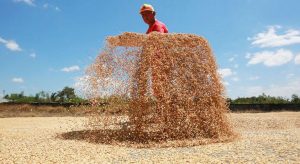July NFA palay procurement hits 10,045 MT
THE National Food Authority (NFA) said on Wednesday that it procured 10,045 metric tons (MT) of palay, or unmilled rice, in July, equivalent to 224,252 bags of 50 kilograms each. It said farmers were attracted to the high purchase price offered by the NFA, which buys from domestic farmers to maintain an emergency reserve of […]

THE National Food Authority (NFA) said on Wednesday that it procured 10,045 metric tons (MT) of palay, or unmilled rice, in July, equivalent to 224,252 bags of 50 kilograms each.
It said farmers were attracted to the high purchase price offered by the NFA, which buys from domestic farmers to maintain an emergency reserve of rice.
The NFA inventory of milled rice was 3,013,048 bags or 150,652 MT in the seven months to July.
“It should be noted that NFA’s inventory is 6.88% of the country’s national rice inventory,” it said.
The NFA Council increased the buying price for palay to P23 to P30 per kilogram (kg) for dry and clean palay and P17 to P23 per kg for fresh palay, depending on location and grade.
“This success is largely attributed to the ongoing PRICERS program, which has effectively encouraged more farmers to deliver and sell their palay harvests to the NFA, particularly in regions experiencing sporadic harvests,” the NFA said in its monthly procurement report.
In April, the NFA changed its procurement strategy to allow it to offer a range of prices depending on the prevailing market price in a given province. The new policy is intended to make the NFA more competitive with private traders in obtaining palay.
The NFA added that the year-earlier procurement for July was only 7,672 bags of palay or about 383 MT.
The July 2024 target had been 200,900 bags.
The NFA is targeting a rice reserve of 495,000 MT by the end of the year. It is required by law to maintain a buffer stock equivalent to about nine days’ demand.
The NFA said it distributed 53,730 bags (2,686.5 MT) of milled rice in July, well below target.
“Sales were calibrated due to the low inventory level of rice,” it added. — Adrian H. Halili























